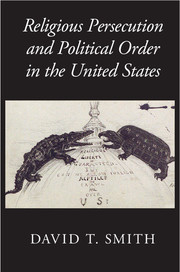Book contents
- Frontmatter
- Dedication
- Contents
- Acknowledgments
- 1 Introduction
- 2 Religious freedom and persecution in America: A theoretical overview
- 3 Joseph Smith and the rise of Mormonism: The political threat of religious charisma
- 4 The federal response to Mormonism
- 5 Jehovah's Witnesses and the flag salute, 1870–1940
- 6 Mass violence against Jehovah's Witnesses, 1940–1942
- 7 The Catholic experience in America
- 8 The Jewish experience in America
- 9 The Islamic experience in America
- 10 Conclusion
- Sources and bibliography
- Index
9 - The Islamic experience in America
Published online by Cambridge University Press: 05 November 2015
- Frontmatter
- Dedication
- Contents
- Acknowledgments
- 1 Introduction
- 2 Religious freedom and persecution in America: A theoretical overview
- 3 Joseph Smith and the rise of Mormonism: The political threat of religious charisma
- 4 The federal response to Mormonism
- 5 Jehovah's Witnesses and the flag salute, 1870–1940
- 6 Mass violence against Jehovah's Witnesses, 1940–1942
- 7 The Catholic experience in America
- 8 The Jewish experience in America
- 9 The Islamic experience in America
- 10 Conclusion
- Sources and bibliography
- Index
Summary
INTRODUCTION
The experience of Islam in the United States makes for a complicated mixed case in this book. Islam is a broader and more diverse religious category than any of the others examined here. Like Judaism and Catholicism, Islam in America is made up of many different communities with distinctive ties of ethnicity and nationality as well as religion. Unlike these other religions, however, there has historically been a lack of mutual recognition between Islamic communities and relatively little sense of a shared Islamic American identity. This has been exacerbated by the presence of groups of Americans who regard themselves as Muslims but whom other Muslims view as unacceptably unorthodox.
These differences within American Islam have been closely related to how the American state has seen and responded to Islam. Throughout most of the twentieth century, state actors regarded immigrant Muslims as a worthy part of the American ethno-religious mosaic. Even when immigration from predominantly Muslim countries was cut off between the 1920s and 1960s, the state saw Muslims as part of a broad coalition of the American faithful who would sustain the country during the protracted fight against Communism. This attitude toward Islam was reflected in a foreign policy that frequently tried to enlist Islam against Communism in the proxy struggles of the Cold War. However, the state was deeply suspicious of any version of Islam that was associated with African Americans. From the beginning, African American Islam in all its varieties was associated with threatening politics. In particular, the heterodox Nation of Islam was subject to extensive surveillance, harassment, and disruption by the FBI and other government agencies who regarded it as a dangerous political movement rather than a legitimate religion.
The criteria constituting threatening and non-threatening Islam began to shift following the Iranian revolution. There was an increased consciousness of “fundamentalist” Islam as something antithetical to American identity, even as the United States continued to nurture fundamentalist Muslim combatants in the Middle East and central Asia. The Ayatollah, a recognizably religious figure, became a popular villain in the American media and public. With the end of the Cold War, the 1993 World Trade Center bombing, and the 1996 bombing of the USS Cole, Islamic fundamentalism became an increasingly prominent domestic and international enemy of the United States. With the 9/11 attacks, Islamic terrorism became the sole pre-eminent enemy, shaping domestic and foreign policy for a decade.
- Type
- Chapter
- Information
- Religious Persecution and Political Order in the United States , pp. 179 - 219Publisher: Cambridge University PressPrint publication year: 2015



